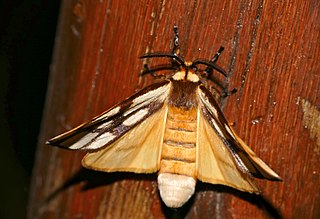Related Research Articles

Argema mimosae, the African moon moth, is a giant silk moth of the family Saturniidae. Similar in appearance to the giant Madagascan moon moth, but smaller, this moth can be found widely in Eastern Africa and more locally in Southern Africa, including near the east coast of South Africa. The species was first described by Jean Baptiste Boisduval in 1847. An adult can measure 10 to 12 centimetres across its wingspan and 12 to 14 centimetres from head to the tip of its elongated tail-like second pair of wings. Its forward wings have a distinctive grey-coloured "furry" leading edge, giving a very rough surface, presumably for aerodynamic reasons. Apart from the eye-like markings on its wings, the colouring and shape of the wings give the appearance of a piece of foliage, especially the tail-like structures of the rearmost wings which resemble a dried out leaf stem - presumably for camouflage in its natural environment.

Anaphe is a genus of moths in the family Notodontidae erected by Francis Walker in 1855.
Lamprosiella is a monotypic moth genus in the subfamily Arctiinae erected by R. J. Collins in 1962. Its only species, Lamprosiella eborella, was described by Jean Baptiste Boisduval in 1847. It is found in South Africa and Tanzania.

Macroglossum milvus is a moth of the family Sphingidae. It is known from Réunion and Mauritius.
Metoecis is a monotypic snout moth genus described by Paul Mabille in 1879. Its only species, Metoecis carnifex, was described by Charles Coquerel in 1855. It is found on Madagascar and South Africa.

Mocis mayeri is a moth of the family Erebidae first described by Jean Baptiste Boisduval in 1833. It has a wide range in Africa, which includes Cameroon, Cape Verde, the Comoros, the Democratic Republic of the Congo, Eritrea, Ghana, Kenya, Réunion, Madagascar, Malawi, Mauritius, Mozambique, Nigeria, Senegal, the Seychelles, Sierra Leone, South Africa, Sudan, Tanzania, the Gambia, Uganda, Zambia and Zimbabwe. It is also found in Saudi Arabia and Yemen.

Scopula minorata is a moth of the family Geometridae. It was described by Jean Baptiste Boisduval in 1833. It is found in Africa south of the Sahara, the Arabian Peninsula and on the islands of the Indian Ocean. Furthermore, it is found in southern Europe. It can be distinguished from Scopula lactaria only by examination of its genitalia.

Polydesma umbricola, the monkeypod moth or large tabby, is a species of moth in the family Erebidae. The species is found in southern Europe, Africa, Asia Minor to southern Asia, of India, Sri Lanka, Maldives, the Andaman Islands, including many Indian Ocean islands, like Coëtivy Island, Aldabra, Assumption Island, Madagascar and on Hawaii.

Phazaca theclata, the cotton leaf roller, is a moth of the family Uraniidae. It was first described by Achille Guenée in 1858. It is known from Africa south of the Sahara, from Saudi Arabia, as well as from India, Japan, Myanmar, Nepal and Sri Lanka.
Amerila madagascariensis is a moth of the subfamily Arctiinae. It was described by Jean Baptiste Boisduval in 1847. It is found on Madagascar.
Epitoxis amazoula is a moth of the subfamily Arctiinae. It was described by Jean Baptiste Boisduval in 1847. It is found in South Africa.
Lepista pandula is a moth of the subfamily Arctiinae. It was described by Jean Baptiste Boisduval in 1847. It is found in Kenya, Malawi, Mozambique, Somalia, South Africa, Tanzania and Uganda.

Anaphe reticulata is a moth of the family Notodontidae. It was described by Francis Walker in 1855. It is found in Angola, Eritrea, Ivory Coast, Malawi, Mozambique and South Africa.
Anaphe venata is a moth of the family Notodontidae. It was described by Arthur Gardiner Butler in 1878. It lives in Angola, Cameroon, the Central African Republic, the Republic of the Congo, the Democratic Republic of the Congo, Equatorial Guinea, Ghana, Ivory Coast, Nigeria, Tanzania and Togo.
Pseudonaclia puella is a moth in the subfamily Arctiinae. It was described by Jean Baptiste Boisduval in 1847. It is found in Kenya, Mozambique, South Africa, Zambia and Zimbabwe.
Thyretes montana is a moth in the family Erebidae. It was described by Jean Baptiste Boisduval in 1847. It is found in South Africa.
Striphnopteryx is a monotypic moth genus in the family Eupterotidae described by Hans Daniel Johan Wallengren in 1858. Its only species, Striphnopteryx edulis, was described by Jean Baptiste Boisduval in 1847. It is found in South Africa, where it has been recorded from KwaZulu-Natal and Mpumalanga.
Phyllalia patens is a moth in the family Eupterotidae. It was described by Jean Baptiste Boisduval in 1847. It is found in Lesotho and KwaZulu-Natal and Mpumalanga in South Africa.
Phyllalia thunbergii is a moth in the family Eupterotidae. It was described by Jean Baptiste Boisduval in 1847. It is found in KwaZulu-Natal in South Africa.
References
- ↑ De Prins, J. & De Prins, W. (2017). "Anaphe panda (Boisduval, 1847)". Afromoths. Retrieved February 16, 2018.
- ↑ Bodenheimer, F.S. (1951). Insects as human food. The Hague: Dr. W. Junk. p. 140.
- ↑ Malaisse, F. (1997). Se nourrir en forêt claire africaine. Approche écologique et nutritionnelle. Belique: Les Presses agronomiques de Gembloux / Centre Technique de Coopération agricole et rurale. p. 211. ISBN 2870160453.
- Pitkin, Brian & Jenkins, Paul. "Search results Family: Arctiidae". Butterflies and Moths of the World. Natural History Museum, London.
| This article on a moth of the family Notodontidae is a stub. You can help Wikipedia by expanding it. |